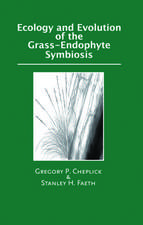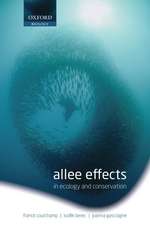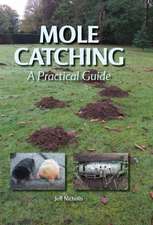Biogeography and Ecology of the Pityusic Islands: Monographiae Biologicae, cartea 52
Editat de K. Kuhbièr, J.A. Alcover, Guerau C. d'Arellano Turen Limba Engleză Paperback – 12 oct 2011
Din seria Monographiae Biologicae
- 24%
 Preț: 2612.51 lei
Preț: 2612.51 lei - 18%
 Preț: 948.92 lei
Preț: 948.92 lei - 15%
 Preț: 648.74 lei
Preț: 648.74 lei -
 Preț: 397.59 lei
Preț: 397.59 lei - 28%
 Preț: 91.90 lei
Preț: 91.90 lei -
 Preț: 379.86 lei
Preț: 379.86 lei -
 Preț: 388.34 lei
Preț: 388.34 lei -
 Preț: 414.91 lei
Preț: 414.91 lei -
 Preț: 395.47 lei
Preț: 395.47 lei -
 Preț: 389.49 lei
Preț: 389.49 lei -
 Preț: 401.24 lei
Preț: 401.24 lei -
 Preț: 394.71 lei
Preț: 394.71 lei -
 Preț: 405.99 lei
Preț: 405.99 lei -
 Preț: 425.84 lei
Preț: 425.84 lei -
 Preț: 381.21 lei
Preț: 381.21 lei -
 Preț: 389.56 lei
Preț: 389.56 lei - 18%
 Preț: 1833.65 lei
Preț: 1833.65 lei - 18%
 Preț: 1230.35 lei
Preț: 1230.35 lei - 18%
 Preț: 1027.08 lei
Preț: 1027.08 lei -
 Preț: 399.67 lei
Preț: 399.67 lei - 18%
 Preț: 2493.72 lei
Preț: 2493.72 lei -
 Preț: 417.59 lei
Preț: 417.59 lei -
 Preț: 404.89 lei
Preț: 404.89 lei - 20%
 Preț: 557.46 lei
Preț: 557.46 lei -
 Preț: 418.76 lei
Preț: 418.76 lei -
 Preț: 408.37 lei
Preț: 408.37 lei - 15%
 Preț: 650.69 lei
Preț: 650.69 lei - 15%
 Preț: 652.31 lei
Preț: 652.31 lei -
 Preț: 395.37 lei
Preț: 395.37 lei - 18%
 Preț: 1232.26 lei
Preț: 1232.26 lei - 15%
 Preț: 637.59 lei
Preț: 637.59 lei - 18%
 Preț: 1231.95 lei
Preț: 1231.95 lei - 18%
 Preț: 1226.90 lei
Preț: 1226.90 lei - 15%
 Preț: 658.22 lei
Preț: 658.22 lei -
 Preț: 353.75 lei
Preț: 353.75 lei - 18%
 Preț: 1224.36 lei
Preț: 1224.36 lei -
 Preț: 386.22 lei
Preț: 386.22 lei - 20%
 Preț: 723.22 lei
Preț: 723.22 lei - 15%
 Preț: 652.49 lei
Preț: 652.49 lei - 18%
 Preț: 1228.62 lei
Preț: 1228.62 lei - 18%
 Preț: 945.30 lei
Preț: 945.30 lei - 18%
 Preț: 1231.64 lei
Preț: 1231.64 lei - 15%
 Preț: 633.68 lei
Preț: 633.68 lei - 20%
 Preț: 572.09 lei
Preț: 572.09 lei - 18%
 Preț: 1844.54 lei
Preț: 1844.54 lei -
 Preț: 386.61 lei
Preț: 386.61 lei
Preț: 419.24 lei
Nou
Puncte Express: 629
Preț estimativ în valută:
80.23€ • 83.45$ • 66.24£
80.23€ • 83.45$ • 66.24£
Carte tipărită la comandă
Livrare economică 10-16 aprilie
Preluare comenzi: 021 569.72.76
Specificații
ISBN-13: 9789400965416
ISBN-10: 9400965419
Pagini: 732
Ilustrații: 702 p.
Dimensiuni: 156 x 244 x 38 mm
Ediția:Softcover reprint of the original 1st ed. 1984
Editura: SPRINGER NETHERLANDS
Colecția Springer
Seria Monographiae Biologicae
Locul publicării:Dordrecht, Netherlands
ISBN-10: 9400965419
Pagini: 732
Ilustrații: 702 p.
Dimensiuni: 156 x 244 x 38 mm
Ediția:Softcover reprint of the original 1st ed. 1984
Editura: SPRINGER NETHERLANDS
Colecția Springer
Seria Monographiae Biologicae
Locul publicării:Dordrecht, Netherlands
Public țintă
ResearchCuprins
1. Introduction.- 2. The Pityusic Islands: a geographical approach.- Geology.- 3. The geological history of Eivissa and Formentera.- 4. A contribution to the knowledge of Pleistocene coastal profiles in the Pityusic Islands.- 5. The climate of Eivissa and Formentera.- Botany.- 6. Contributions to the higher fungal flora of Eivissa.- 7. An approach to the bryophytic flora of the Pityusic Islands.- 8. The genus Allium (Alliaceae) on the Pityusic Islands.- 9. Vegetation of the Pityusic Islands.- 10. Botanic bibliography of the Pityusic Islands.- Zoology.- 11. Terrestrial and fresh-water gastropods of the Pityusics (Eivissa and Formentera, excluding Trochoidea (Xerocrassa) Monterosato 1892.- 12. Trochoidea (Xerocrassa) caroli (Dohrn & Heynemann 1862) and its races on the Pityusic Islands (Baleares) Spain — Gastropoda: Helicidae.- 13. Tenebrionidae of the Pityusic Islands (Coleoptera: Heteromera).- 14. Ants of the Pityusic Islands (Hym. Formicidae).- 15. Bees and wasps on Eivissa: faunistic notes on Hymenoptera Aculeata.- 16. Lepidoptera of the Pityusic Islands.- 17. Heteroptera of Eivissa and Formentera.- 18. Siphonaptera from small terrestrial mammals in the Pityusic Islands.- 19. A taxonomic study of the Eivissa wall lizard, Podarcis pityusensis Boscá 1883.- 20. The amphibians and reptiles of the Pityusic Islands.- 21. Subrecent small mammal fauna of Eivissa.- 22. Mammals of the Pityusic Islands.- 23. Helminthfauna from small mammals (insectivores and rodents) on the Pityusic Islands.- 24. Some faunal and biogeographic considerations on the avifauna of Eivissa.- Man.- 25. The Prehistory of Eivissa and Formentera.- 26. Notes on the folk architecture of Eivissa.- 27. Exploitation in the Pityusic Islands of three plant species.- 28. The language of the Pityusic people.-29. Isolation and its genetic consequences in the population of Formentera: inbreeding, isonymy and drift.- Conservation.- 30. La conservación de la Vida Salvaje en las Pitiusas.















